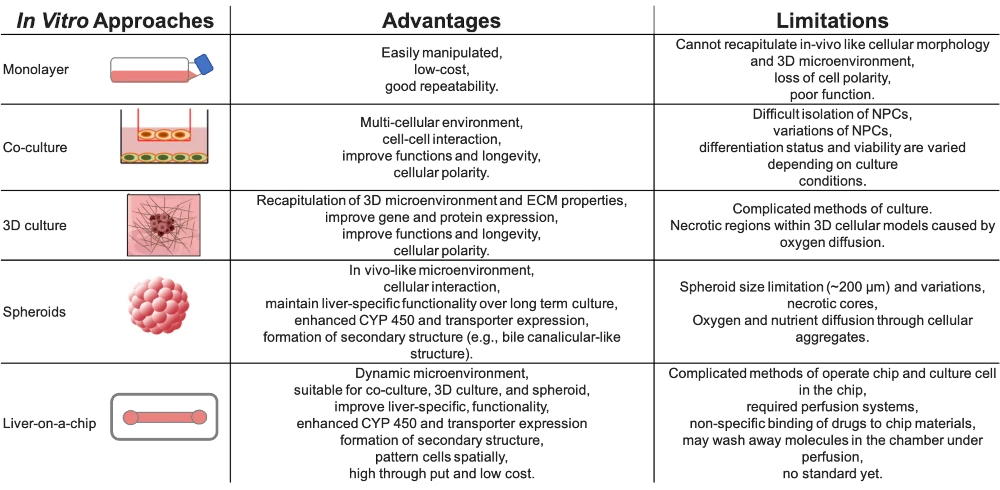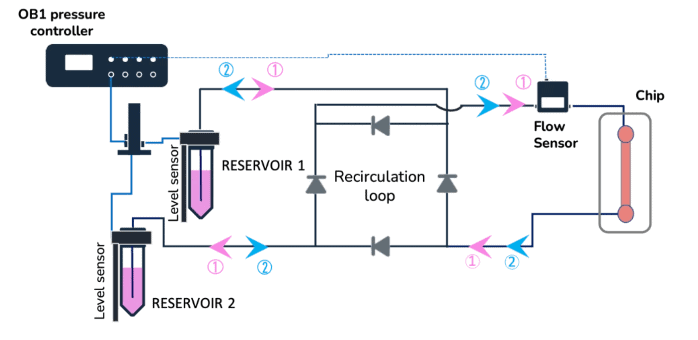LIVER-ON-A-CHIP MODEL
Improve your reproducibility with physiological culturing conditions
Automated and controlled supply of nutrients in a stable flow
Test different conditions at the same time
Image credit: High-speed BCARS allows detailed mapping of specific components of tissue samples. A false-color BCARS image of mouse liver tissue (left) picks out cell nuclei in blue, collagen in orange and proteins in green. An image of tumor and normal brain tissue from a mouse (right) has been colored to show cell nuclei in blue, lipids in red and red blood cells in green. Images show an area about 200 micrometers across. Credit: Camp/NIST.
Why use liver-on-a-chip models?
The quest for more reproducible models to advance drug development and disease research is in full swing. Current animal models are known to have limitations when translating from preclinical to human trials, especially when considering effects on the liver.
A striking example is that almost half of the drugs found safe in established animal models were responsible for liver damage in clinical trials [1]. Thus, there are several approaches to improve translation between preclinical and clinical data, as illustrated in the table below [adapted from 1].
Every method has shortcomings, but liver-on-a-chip models offer the possibility to perform all the in vitro models, taking benefits from their advantages. As a new technology, there are no standards yet, and operating organ-on-a-chip systems requires specialized know-how. This is precisely what we are aiming to simplify with our platform.
Advantages and limitations of in-vitro liver models [1]

References
1. Deng J, Wei W, Chen Z, Lin B, Zhao X. Engineered liver-on-a-chip platform to mimic liver functions and its biomedical applications: a review, Micromachines. 2019; 10(10):676. https://doi.org/10.3390/mi10100676
2. Shin JY, Park J, Jang HK, Lee TJ, La WG, Bhang SH, Kwon IK, Kwon OH, & Kim BS. Efficient formation of cell spheroids using polymer nanofibers. Biotechnology letters. 2012; 34(5):795–803. https://doi.org/10.1007/s10529-011-0836-9
3. Moriyama M, Sahara S, Zaiki K, Ueno A, Nakaoji K, Hamada K, Ozawa T, Tsuruta D, Hayakawa T, & Moriyama H. Adipose-derived stromal/stem cells improve epidermal homeostasis. Scientific reports. 2019; 9(1):18371. https://doi.org/10.1038/s41598-019-54797-5
How to culture a liver-on-a-chip model?
To simplify and standardize the organ-on-chip cultures, we have assembled a platform that automates most of the labour-intensive work. Although the schematics below might seem complicated, the principle is simple.
The OB1 pressure controller and the flow sensor control the media flow inside the chip according to your needs and parameters. The recirculation loop redirects the media between the reservoirs so your liver-on-chip model always receives enough nutrients while also being enriched with metabolites for later analysis. The level sensors are responsible for controlling which reservoir will empty first and ensuring that there is always media on top of your culture.
You can add your own proprietary chip to the system or commercial ones, as you prefer. This system is assembled as an automated platform that fits inside standard CO2 incubators and biosafety hoods.

The liver-on-a-chip pack includes:
- An OB1 flow controller (Elveflow)
- A Microfluidic flow sensor (MFS or BFS, Elveflow)
- Several Falcon reservoirs
- Recirculation loop
- Tubings and fittings
- Level sensors
- Microfluidic chip of your choice
- ESI Software (Elveflow)
- User guide
Check our automated cell culture platform for more details on an integrated approach!
Customize your pack
Our instruments are compatible with standard commercialized chips from different brands.
Our Packs can be modified depending on your specific needs. In this light, our microfluidic specialists will advise you on the best instruments and accessories based on your needs and will accompany you during the setup of the microfluidic platform.
– Check our other Packs for various applications –
Can I order a pack?
Since Packs are products that are still being developed, we have a few eligibility criteria to maximize their success rate. A discussion with our experts is needed to determine your specific needs to offer you a personalized response.
Can the platform be sterilized/autoclaved?
The components of the cell culture platform can be sterilized. Our user guide provides detailed information on how to do it.
Can a pack be customized based on my specific application?
Yes! Our experts will establish which instruments are best suited for your application, such as the type of flow sensor or the number of flow controller channels you need to perform your experiment. Drop us a line at innovation@microfluidic.fr.
Can I buy individual instruments?
You can order the instruments on the product section of our website.
Funding and Support
The ALTERNATIVE and LIFESAVER projects helped develop this instrument pack. These projects are funded by European Union’s H2020-LC-GD-2020-3, grant agreements No. 101037090 (ALTERNATIVE) and 101036702 (LIFESAVER).


